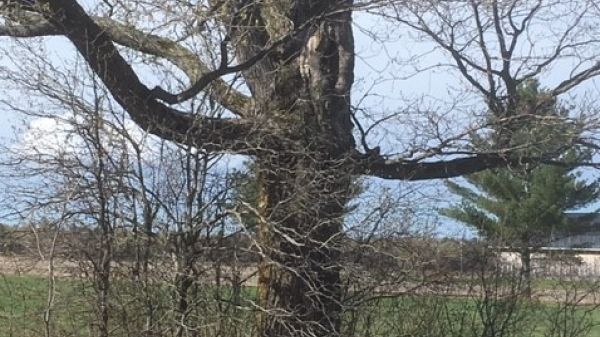A big old tree, is a big old tree, is a big old tree! Or is it? A question about educators' and teachers' perspectives and educational objectives.

A big old tree, is a big old tree, is a big old tree! Or is it?
A question about educators’ and teachers’ perspectives and educational objectives.
Blog 4 by Suzanne Major Ph. D., Anthropology of Early Childhood Education
Is a big old tree a hub for wild bee honeycombs? Is it a secret home for fairies or leprechauns? Or is it a terminal for an underground biological internet?[1] It depends on the perspectives of the educators and teachers who are promoting either a concrete approach to nature (securing shelter, food, clothing and survival in an ecosystem) or literacy, alphabetization or "opsistiationˮ[2] (securing the best possible place in a socioeconomic system). "Opsistiation" means instruction and education through images and sounds using screens. For some educators and teachers, a perspective might be a soup of mixed information, ideas, beliefs and values, but it can be an organized and conscious understanding of interacting domains of knowledge.
A concrete approach to nature, literacy, alphabetization and ̋opsistiationˮ are intellectual systems used to make sense of the outside world and understand how it acts on us and how we can act on it.[3] A concrete approach to nature or if you will, developing a concrete mind,[4] is marked by "immanenceʺ as in living with or being rooted in an ecosystem. Literacy, alphabetization and "opsistiationˮ are marked by "transcendenceʺ[5] as in using, exploiting and dominating an ecosystem. Let’s think of these four intellectual systems as kingdoms of knowledge that we can visit as we try to strike a balance for survival by promoting environmental education towards sustainability.
It has been my experience as a teacher, educator and anthropologist that there is one big difficulty when implementing a program in early childhood. The global approach for development and education through play is work that belongs to children but the pedagogical approach within our four kingdoms of knowledge is work that belongs to educators and teachers. It’s all about what happens after the child lifts the rock, finds the worm and the adult echoes the surprise to reinforce exploration and discovery. The Guidelines for Excellence. Early Childhood Environmental Education Programs (2016) endorsed by the NAAEE is a solid framework for environmental education in early childhood and childhood. Its program philosophy, its baseline focusing on developmentally appropriate practices, its approach through play and exploration as well as its curriculum framework, its settings and professional training recommendations represent a rich heritage bestowed upon us through time by many thinkers and practitioners. Everyone interested in setting up a school or centre for environmental education in early childhood should start with this document. It is deeply rooted in the kingdoms of literacy, alphabetization and ʺopsistiationˮ. Educators and teachers must find their place within the kingdoms and clearly define what they are promoting and what strategies they are using to do so. From this they can establish educational objectives and monitor their work through observation, documentation and concertation.
In the NAAEE document, Ruth Wilson proposes basic goals such as ʺthe development of a sense of wonder, the appreciation for the beauty and mystery of the natural world, (having) opportunities to experience the joy of closeness to nature, the respect for other creatures, development and the appreciation of the world around usˮ. (2016: 2) Theses goals appeal to the children’s emotions. They are valuable elements for the children’s global approach to development and education. The hope is that in promoting theses goals, children will develop empathy for the natural world and work to protect it and even save it. It’s a tall order for little ones but we need all the help we can get! Educators and teachers re-enact these emotions as a strategy to rally children to their cause. They hope to set them on the track of empathy, imitation and endorsement as they count on their natural disposition for composing a ˮtransductive identityʺ in the early years. This means adopting an identity just because it’s valued by people we know and respect and because we are hurried and pressured to do so. A transductive identity is temporary and will hold until the children can compose a more personal identity through their own experiences. It’s like watching someone fishing, imitating him or her to learn the ropes and then going out fishing ourselves. Some things will be lost. Some things will be gained.
A sense of wonder, mystery, beauty, closeness, and the development and appreciation of the world around us come from the kingdoms of literacy, alphabetization and ˮopsistiationˮ. They give us the great tools of imagination, conceptualization and creativity. Attention, respect, fear, hardship, isolation, amazement, gratefulness and the development of strength to ensure survival comes from the kingdom of the concrete mind. It equips us with complex descriptive and functional knowledge, analogies and metaphors. It appeals to the children’s feelings rather than their emotions, and to the sense they make of the knowledge they get through experience, manipulation and exploration. Within each of the four kingdoms, educational goals can be defined, strategies can be identified, and experiences can be organized to ensure development and education. A big old tree can be the hub for wild bee honeycombs, the secret home of fairies or leprechauns and a terminal for an underground biological internet. Educators and teachers can look to foster descriptive knowledge about the tree, generate a favourable emotional response to help protect the tree or explore new knowledge about the interconnectedness between the tree, mushrooms and microorganisms, as different strategies within specific kingdoms of knowledge.
Each kingdom has its basic principles, dominating processes and specific strategies. Educators and teachers need to identify them to define general and specific educational objectives. Children’s roles for example are different. The concrete mind calls on the participant, literacy calls on the explorer,[6] alphabetisation calls on the creator [7]and ˮopsistiationʺ calls on the spectator.[8] The environments they live and learn in are different. The concrete mind evolves in nature and reality through experimentation. Literacy proposes rooms, artificial material and miniature equipment for manipulation. Alphabetization also uses rooms and artificial material but fosters conceptualization, imagination and creativity. ʺOpsistiationˮ offers rooms, screens, virtual realities and ʺaugmentationsˮ to help children develop memory, define identities and accumulate huge amounts of information. ˮAugmentationsʺ means making things more real than life. The concrete mind for children playing outside uses all five senses and develops their ʺcombined frequency.ʺ [9] Literacy for children from birth to five years old, uses all five senses but only one at a time considering the children’s developmental age. Alphabetization for children over three years old uses sight and touch and ʺopsistiationˮ for children twelve months and older, uses sight and hearing.
Each kingdom of knowledge creates a humanity of its own. And of course, no one belongs purely to one or the other kingdom. In the modern world, developing the concrete mind has been neglected but there are signs that this is about to change as young people are now capable of integrating knowledge from all four kingdoms bringing about yet again ˮ a brave new world ʺ. If developing empathy and helping to protect nature is certainly possible, thinking that children of the twenty-first century can acquire the knowledge to save it is a romantic notion. The ʺredemption child ˮ [10] can’t access new knowledge and technologies fast enough to outrun the rate of destruction that was put in motion by modern economies and their worldwide ambitions.
Not withstanding this contemporary apocalyptic threat (every generation had its own), children are accumulating huge amounts of information, reorganizing general knowledge and developing new cognitive abilities. Their lines of thoughts are less linear and more stratified, and they go in all directions being free of fear. Older children and young people show us that their thinking process has changed, accelerated by the fact that they don’t learn information, they simply stock it and refer to it. They save a lot of energy in their learning process by first identifying a global contextual experience they are interested in like nature walks and hiking. After checking other people’s experiences on the internet where they get massive amounts of second-hand information they are ready for experimenting and trying out problem solving. But before stepping out they go through the process of identification by acquiring its markers. They buy a hat, boots, coat, bag sac, pocket-knife, GPS and whatnot to create a starting kit. Then they get on their way! Now what should they do when they come across an angry mother wolverine on the walking path (a real story)? Do they freak out, run away, carelessly approach the animal or very carefully and calmly back off? It all depends on the individuals. From problem solving they acquire personal and significant information and develop corresponding abilities. What has changed? The coming of age of child centred instead of adult centred pedagogy? Consider the following:
Today’s children:
Choose an experience of interest among a vast number of experiences
Engage in the process of identification by referring to second-hand information and acquiring identity makers
Engage in problem solving
Acquire first-hand information
Develop significant abilities
Yesterday’s children:
Learned given information
Practised abilities valued by adults
Engaged in problem solving chosen by adults
Chose an experience of interest among a limited number of experiences
Engaged in the process of identification by using first-hand information and acquiring identity markers
Children today don’t settle for simply fulfilling their needs but pursue their every desire as a given. We need to know that children can go way beyond recycling and feeling empathy for nature, but the question is can we see how? Young people will survive the coming storm. They will pull up knowledge from the kingdom of the concrete mind and use abilities provided by all four kingdoms of knowledge to build or rebuild. The question for us now is can educators and teachers be part of it by developing and adapting our pedagogical approach? Tell me what you think?
SM/sm 20-05-19
[1] Wohlleben, P. (2015). The Hidden Life of Trees. What they feel. How they communicate, Greystone, David Suzuki Institute, 272 pages.
[2] Major, S. (2014). Mamès, profèsorn oun kinder likth. Éducation en petite enfance en CPE. Le cas des femmes hassidiques Belz en services de garde en milieu familial accrédités, Ph. D. thesis, Université de Montréal, Anthropology, 294 pages.
[3] Major, S. (2018). Blog 1 for the NAAEE
[4] Jousse, M. (1974). Anthropologie du geste, Gallimard, 395 pages
[5] Deleuze. G & Guattari, F. (1980). Capitalisme et schizophrénie 2. Mille plateaux, Les éditions de Minuit, 645 pages. [6] Major, S. (2014: 105). Idem
[7] Illich, Y. (2004 : 191). La perte des sens, Fayard; Louv, R. (2008 : 166). Last Child in the Woods. Saving our Children from Nature-Deficit Disorder, Algonquin Paperbacks
[8] Illich, Y. Idem; Louv, R. (2008: 15), Idem.
[9] Major, S. (2014: 132). Idem. [10] Dalhberg, G. & Moss, P. (2007: 56). Au-delà de la qualité, vers l’éthique et la politique en matière d’éducation préscolaire, in Brougère, G. & Vandenbroeck, M., Repenser l’éducation des jeunes enfants, P.I.E, Peter Lang. 53-76.
